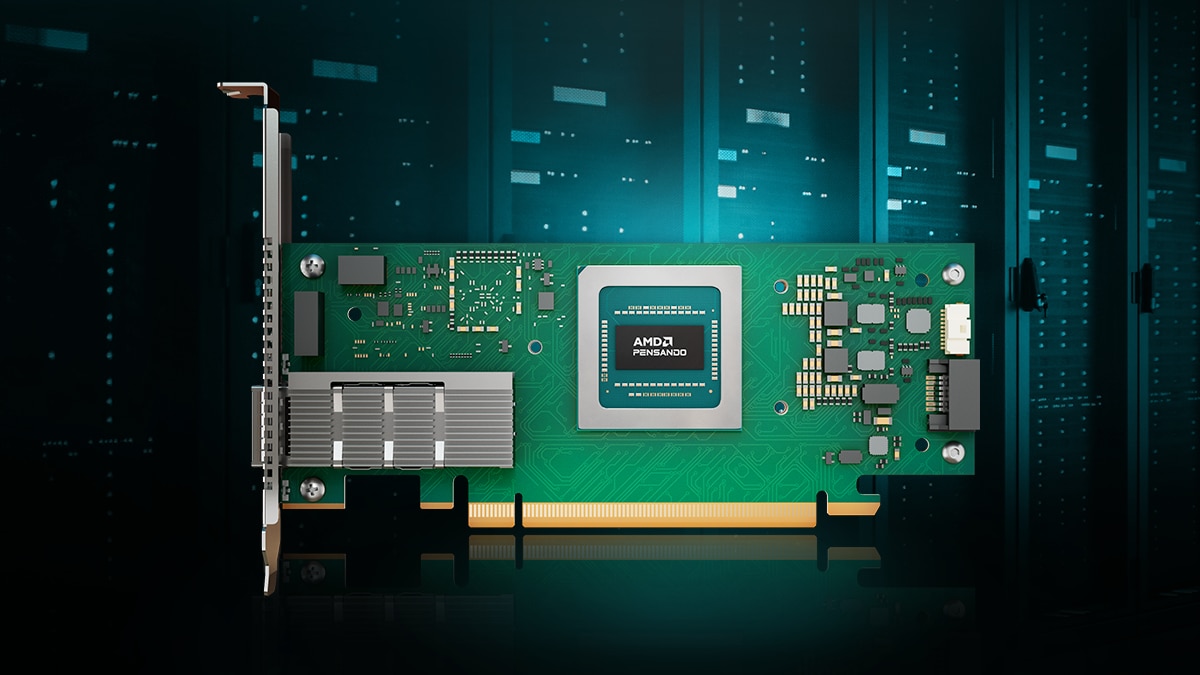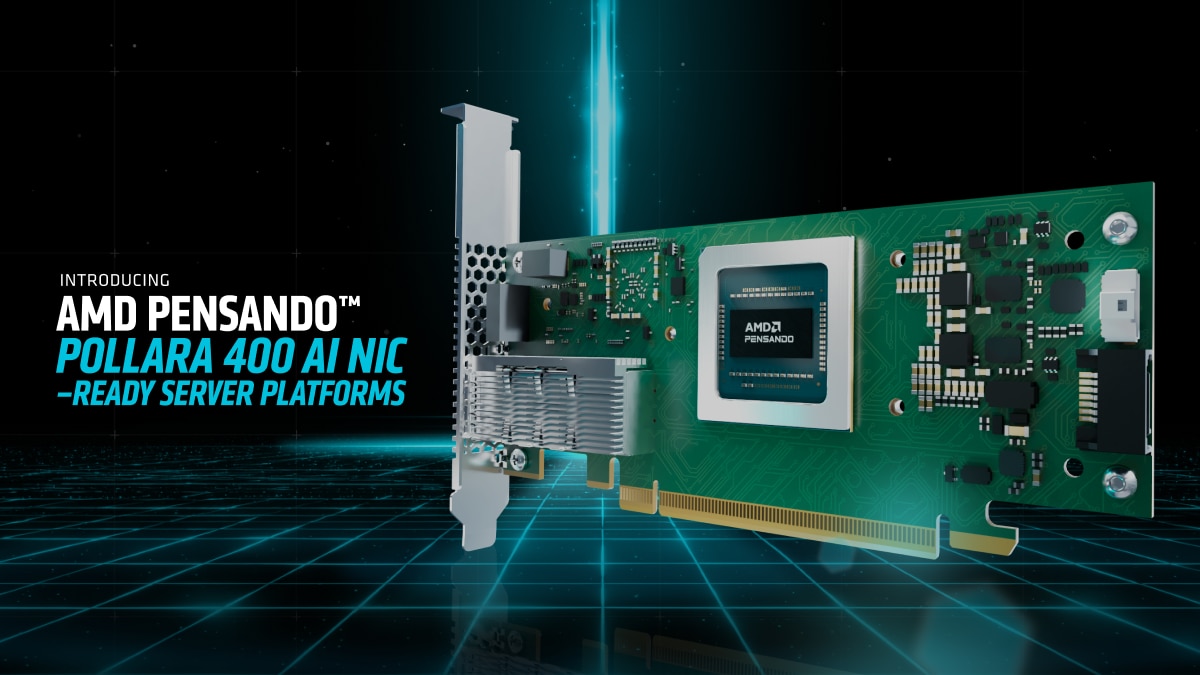Driving AMD EPYC CPU-Based Storage Solutions for Enterprise
Jul 17, 2025

AMD is well-known for driving leadership compute in the data center, including CPU leadership with AMD EPYC™ processors as well as GPU advancement with AMD Instinct™ processors. Not to be overlooked in the configuration of these servers is storage. As important as compute is to enable business processes and applications, it would be meaningless without appropriate data storage systems to provide data security, backup, and recovery on the valuable data that the enterprise is collecting and generating.
To that end, AMD collaborates alongside original equipment manufacturers (OEMs) as well as independent software vendors (ISVs) to develop storage solutions for a variety of customer use cases. The numerous OEM platforms and ISV solutions described in this blog are intended to serve as a guide, not an exhaustive list, for end users seeking AMD-based storage options. For the most up-to-date information on storage solutions featuring AMD EPYC processors, please refer to the respective OEM and ISV websites.
Many of these solutions also intersect with the growing compute and storage needs of artificial intelligence (AI), as the typical training processes involve enormous amounts of data in order to effectively determine model weights.
Minimizing the “Noisy Neighbour” Issue with AMD EPYC Chiplet Architecture
In addition to the generational improvements that AMD brings with subsequent AMD EPYC product releases, such as transitions to the latest PCIe® and DDR technologies, AMD EPYC CPUs are well-positioned with their underlying chiplet architecture to mitigate the “noisy neighbour” challenges that shared infrastructure users are prone to experiencing.
When a system shares its resources, such as network bandwidth, CPU, and memory, amongst multiple tenants, the activity of one or more tenants can degrade the experience of the other tenants on the same system due to resource monopolization. While there are numerous methods that infrastructure owners can consider for minimizing the ”noisy neighbour” issue, including implementation of dynamic resource allocation and building in margin of resources (e.g., opting for storage devices providing sufficient input/output operations per second) to account for above average demand, the AMD chiplet architecture inherently allows infrastructure providers to scale to a greater number of users while minimizing “noisy neighbour” performance degradation for individual users.
By organizing its CPU cores and L3 cache into core complex dies (CCDs), each CCD can be viewed as having dedicated resources for memory access. As a result, larger groupings of CCDs imply proportional increases to total L3 cache as well as memory bandwidth. Multiple, separate tenants can also occupy different CCDs and leverage their own dedicated L3 cache and memory bandwidth, leading to isolation of noisy neighbours.
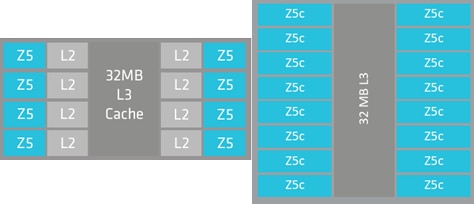
A “Zen 5” CCD with 8 cores per die includes up to a 32 MB cache (left). A “Zen 5c” CPU die holds a total of 16 cores per die (right). Retrieved from the 5th Gen AMD EPYC Processor Architecture whitepaper.
Contrast this approach to the scenario where all cores in a package share a unified L3 cache; as the number of cores sharing the same L3 cache and memory bandwidth increases, the challenge of resource contention arises, leading to the “noisy neighbour” problem described above.
OEM Solutions
AMD has long since been a partner of industry-leading OEMs, including, in alphabetical order, the likes of Dell, HPE, Lenovo, and Supermicro, for development of AMD EPYC processor-based platforms. In addition to providing a range of rack mounted server options in 1U and 2U configurations, these OEMs have developed storage platforms based on AMD EPYC processors.
Dell
The Dell storage portfolio with AMD consists of the PowerFlex and PowerEdge series.
PowerFlex – with multiple hardware consumption options, including rack, appliance, and custom node, PowerFlex infrastructure is intended to be deployed alongside PowerFlex software and PowerFlex manager for high performance applications and heterogeneous environments.
There are two varieties of AMD EPYC processor-powered PowerFlex solutions: R6625 (1RU) and R7625 (2RU), both built upon the AMD EPYC 9004 series, also referred to as 4th Generation AMD EPYC processors. While the underlying CPU technology is the same in both AMD processor-based PowerFlex options, customers can pick between the three consumption options below that determine the extent of integrated networking:
- PowerFlex rack provides the greatest extent with integrated networking,
- PowerFlex appliance provides users with the choice of full or partial network automation, and
- PowerFlex custom node relies on end users to decide on network management.
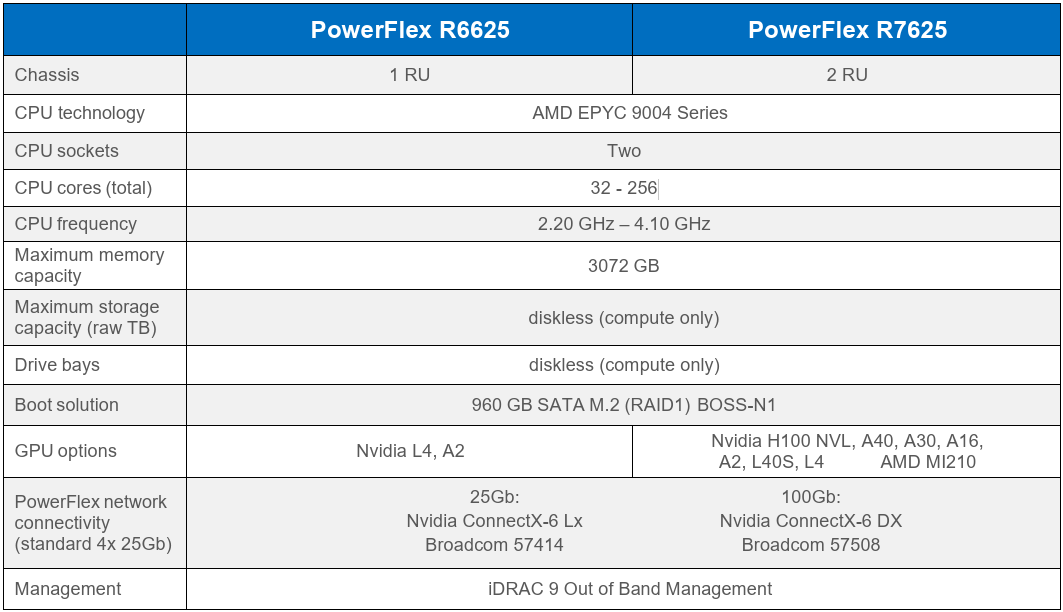
Retrieved from the Dell PowerFlex R6625 and R7625 Specification Sheet
PowerEdge – this product series offers configurations supporting a range of AMD EPYC processor generations, from 2nd Generation to 5th Generation.
- Equipped with all-flash software defined storage (SDS), the PowerEdge R7525 is powered by 2nd or 3rd Generation AMD EPYC processors and suitable for a variety of data center applications. Its configurations with AMD Instinct MI100 GPUs and Nvidia A100 GPUs broaden the R7525’s coverage to include machine learning and HPC workloads.
- Supporting 4th Gen AMD EPYC processors in this product line up is the PowerEdge R7625, a 2U 2P server supporting DDR5 and optional direct liquid cooled (DLC) configurations. The PowerEdge R7615 similarly supports 4th Gen EPYC processors, but in a 2U 1P configuration for compelling performance per investment dollar. For 1U offerings, the PowerEdge R6625 and R6615 offer 1U 2P and 1P configurations, respectively, as flexible, low latency storage platforms with air and DLC optionality.
- The PowerEdge R7725 and R7715 rack servers, supporting the latest AMD 5th Generation EPYC processors, are also storage optimized and certified by Dell for VMware and RedHat OpenShift. With dual OCP network optionality and DDR5 memory support, the 2U 2P R7725 server maximizes performance by packing up to 50% more cores [1], while the 2U 1P R7715 platform provides up to 2x better performance compared to previous generation platforms [2], thereby driving compelling uplift and adaptability for a range of workload requirements.
Dell vSAN ReadyNode configurations are listed starting on pages 76-88 of this document. Options paired with AMD 4th Gen EPYC processors (various CPU SKUs) include, but are not limited to, the following, listed in order of presentation in the source document. Customers are advised to contact their Dell sales representatives for detailed SKU names for the below vSAN ReadyNode configurations.
PowerEdge System |
Platform Name |
Raw Storage Capacity (TB) |
R7625 |
AMD-AF-4-Dell-PowerEdge R7625 |
7.68 |
AMD-AF-6-Dell-PowerEdge R7625 |
38.4 |
|
AMD-AF-6-Dell-PowerEdge R7625 |
40.32 |
|
AMD-AF-8-Dell-PowerEdge R7625 |
38.4 |
|
R7615 |
AMD-AF-4-Dell-PowerEdge R7615 |
7.68 |
AMD-AF-6-Dell-PowerEdge R7615 |
38.4 |
|
AMD-AF-6-Dell-PowerEdge R7615 |
40.32 |
|
AMD-AF-8-Dell-PowerEdge R7615 |
38.4 |
|
AMD-HY-4-PowerEdge R7615 |
4.8 |
|
AMD-HY-6-PowerEdge R7615 |
25.2 |
|
AMD-HY-8-PowerEdge R7615 |
24 |
|
R6625 |
AMD-AF-4-Dell-PowerEdge R6625 |
9.6 |
AMD-AF-6-Dell-PowerEdge R6625 |
15.36 |
|
AMD-AF-8-Dell-PowerEdge R6625 |
15.36 |
|
R6615 |
AMD-AF-4-Dell-PowerEdge R6615 |
9.6 |
AMD-AF-6-Dell-PowerEdge R6615 |
15.36 |
|
AMD-AF-8-Dell-PowerEdge R6615 |
15.36 |
|
AMD-HY-4-PowerEdge R6615 |
6 |
|
AMD-HY-6-PowerEdge R6615 |
9.6 |
|
AMD-HY-8-PowerEdge R6615 |
19.2 |
AMD 4th Gen EPYC CPU-based Dell VMware vSAN ReadyNode Configurations
AMD 2nd and 3rd Gen EPYC CPU-based VMware vSAN ReadyNode configurations are summarized below in order of description on pages 127-170:
PowerEdge System |
Platform Name |
Raw Storage Capacity (TB) |
R7515 |
AMD-AF-6-DELLEMC-R7515 (“Milan”) |
11.52 |
AMD-AF-6-DELLEMC-R7515 (“Milan”) |
9.6 |
|
AMD-AF-6-DELLEMC-R7515 (“Milan”) |
40.32 |
|
AMD-HY-2-DELLEMC-R7515 (“Milan”) |
2.4 |
|
AMD-HY-4-DELLEMC-R7515 (“Milan”) |
6 |
|
AMD-HY-6-DELLEMC-R7515 (“Milan”) |
9.6 |
|
AMD-HY-8-DELLEMC-R7515 (“Milan”) |
25.2 |
|
AMD-AF-DELLEMC-R7515 (“Rome”) |
9.6 |
|
AMD-AF-DELLEMC-R7515 (“Rome”) |
11.52 |
|
AMD-AF-DELLEMC-R7515 (“Rome”) |
40.32 |
|
AMD-AF-6-DELLEMC-R7515 (“Rome”) |
9.6 |
|
AMD-AF-6-DELLEMC-R7515 (“Rome”) |
11.52 |
|
AMD-AF-6-DELLEMC-R7515 (“Rome”) |
40.32 |
|
AMD-AF-8-DELLEMC-R7515 (“Rome”) |
40.32 |
|
AMD-HY-DELLEMC-R7515 (“Rome”) |
2.4 |
|
AMD-HY-DELLEMC-R7515 (“Rome”) |
6 |
|
AMD-HY-DELLEMC-R7515 (“Rome”) |
9.6 |
|
AMD-HY-DELLEMC-R7515 (“Rome”) |
25.2 |
|
AMD-HY-2-DELLEMC-7515 (“Rome”) |
2.4 |
|
AMD-HY-4-DELLEMC-7515 (“Rome”) |
6 |
|
AMD-HY-6-DELLEMC-7515 (“Rome”) |
9.6 |
|
AMD-HY-8-DELLEMC-7515 (“Rome”) |
25.2 |
|
R6515 |
AMD-AF-4-DELLEMC-R6515 (“Milan”) |
7.68 |
AMD-AF-4-DELLEMC-R6515 (“Milan”) |
13.44 |
|
AMD-AF-6-DELLEMC-R6515 (“Milan”) |
11.52 |
|
AMD-AF-6-DELLEMC-R6515 (“Milan”) |
15.36 |
|
AMD-HY-2-DELLEMC-R6515 (“Milan”) |
2.4 |
|
AMD-HY-4-DELLEMC-R6515 (“Milan”) |
4.8 |
|
AMD-HY-6-DELLEMC-R6515 (“Milan”) |
9.6 |
|
AMD-HY-8-DELLEMC-R6515 (“Milan”) |
16.8 |
|
AMD-AF-DELLEMC-R6515 (“Rome”) |
7.68 |
|
AMD-AF-DELLEMC-R6515 (“Rome”) |
11.52 |
|
AMD-AF-DELLEMC-R6515 (“Rome”) |
13.44 |
|
AMD-AF-DELLEMC-R6515 (“Rome”) |
15.36 |
|
AMD-AF-4-DELLEMC-R6515 (“Rome”) |
7.68 |
|
AMD-AF-4-DELLEMC-R6515 (“Rome”) |
13.44 |
|
AMD-AF-6-DELLEMC-R6515 (“Rome”) |
11.52 |
|
AMD-AF-6-DELLEMC-R6515 (“Rome”) |
15.36 |
|
AMD-AF-8-DELLEMC-R6515 (“Rome”) |
15.36 |
|
AMD-HY-DELLEMC-R6515 (“Rome”) |
2.4 |
|
AMD-HY-DELLEMC-R6515 (“Rome”) |
4.8 |
|
AMD-HY-DELLEMC-R6515 (“Rome”) |
9.6 |
|
AMD-HY-DELLEMC-R6515 (“Rome”) |
16.8 |
|
AMD-HY-2-DELLEMC-R6515 (“Rome”) |
2.4 |
|
AMD-HY-4-DELLEMC-R6515 (“Rome”) |
4.8 |
|
AMD-HY-6-DELLEMC-R6515 (“Rome”) |
9.6 |
|
AMD-HY-8-DELLEMC-R6515 (“Rome”) |
16.8 |
|
R6525 |
AMD-AF-4-DELLEMC-R6525 (“Milan”) |
13.44 |
AMD-AF-6-DELLEMC-R6525 (“Milan”) |
11.52 |
|
AMD-AF-6: PowerEdge R6525 (“Milan”) |
13.44 |
|
AMD-AF-DELLEMC-R6525 (“Rome”) |
7.68 |
|
AMD-AF-DELLEMC-R6525 (“Rome”) |
11.52 |
|
AMD-AF-DELLEMC-R6525 (“Rome”) |
13.44 |
|
AMD-AF-4-DELLEMC-R6525 (“Rome”) |
7.68 |
|
AMD-AF-6-DELLEMC-R6525 (“Rome”) |
11.52 |
|
AMD-AF-6-DELLEMC-R6525 (“Rome”) |
13.44 |
|
R7525 |
AMD-AF-6: PowerEdge R7525 (“Milan”) |
26.88 |
AMD-AF-DELLEMC-R7525 (“Rome”) |
9.6 |
|
AMD-AF-DELLEMC-R7525 (“Rome”) |
11.52 |
|
AMD-AF-DELLEMC-R7525 (“Rome”) |
26.88 |
|
AMD-AF-6-DELLEMC-R7525 (“Rome”) |
9.6 |
|
AMD-AF-6-DELLEMC-R7525 (“Rome”) |
11.52 |
|
AMD-AF-6-DELLEMC-R7525 (“Rome”) |
26.88 |
|
AMD-AF-DELLEMC-C6525 (“Rome”) |
9.6 |
AMD 2nd Gen and 3rd Gen EPYC CPU-based Dell VMware vSAN ReadyNode Configurations
For those seeking to deploy Nutanix® Cloud Platform, Dell’s XC core hyperconverged appliances are a suitable option for virtualized environments. The Dell XC Core XC7625 16G generation platform, supporting dual 4th Gen EPYC processors per platform and up to 128 cores per processor, combines compute with the storage capability enabled by Dell PowerFlex solutions.
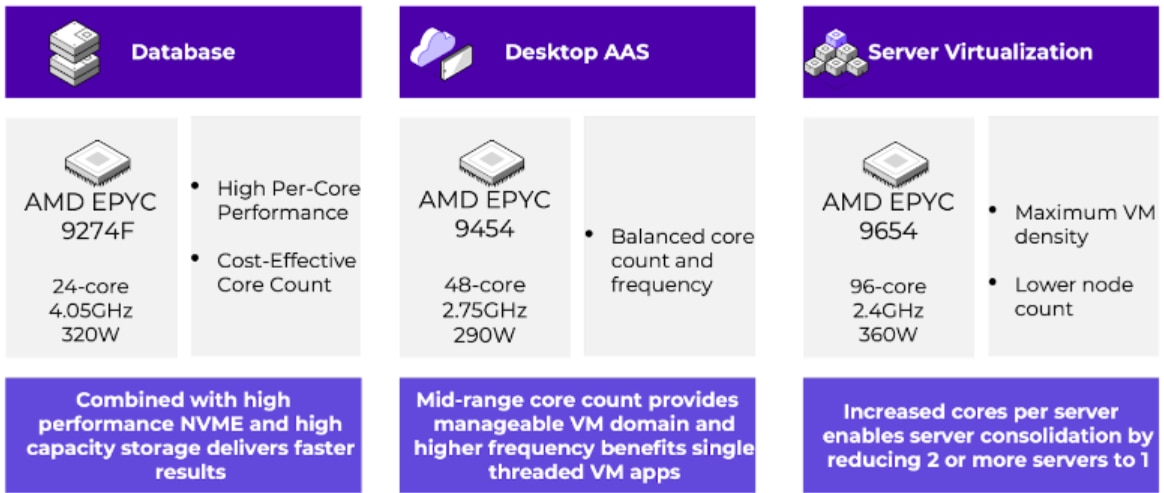
Sample AMD EPYC processor recommendations for the XC7625 are listed here.
HPE
On the HPE front, the three storage solutions available today are: 1) SimpliVity 325, 2) Alletra Storage MP, and 3) DL345:
1. SimpliVity 325 – designed to provide hyperconverged infrastructure (HCI) choice in a 1P 1U chassis, this platform supports virtualization and I/O intensive workloads.
Platform Specifications |
AMD EPYC Processor Family |
Maximum Memory |
Supported Storage |
SimpliVity 325 Gen11 |
4th Generation AMD EPYC Processors |
128 GB to 3072 GB per node |
4x1.92 TB SSD Kit FTT1 (4.6 TB) |
SimpliVity 325 Gen10 plus v2 |
3rd Generation AMD EPYC Processors |
256 GB to 2048 GB per node |
Extra Small - 4x1.92 TB SSD Kit FTT1 (4.6 TB) Small - 6x1.92 TB SSD Kit FTT2 (7.5 TB) Medium - 8x1.92 TB SSD Kit FTT1 (10 TB) |
AMD EPYC™ CPU-based HPE SimpliVity 325 Gen 11 and Gen10 plus v2 options
2. Alletra Storage MP – HPE’s Alletra disaggregated HCI (dHCI) solution is a modular one suitable for mixed workloads at scale, including virtualization and AI applications. Utilizing AMD EPYC Embedded Series processors, the HPE Alletra Storage MP pairs with HPE GreenLake to provide enterprise performance for data-intensive applications, including those requiring block or file storage.
3. HPE ProLiant DL345 – certified for both VMware® and RedHat OpenShift®, this 2U 1P platform supporting both AMD 4th and 5th generation EPYC processors in its Gen11 iteration is well-designed for data intensive storage workloads. The HPE ProLiant DL325 Gen 11 server is the 1U variant of the DL345, also supporting a single processor. Both the HPE ProLiant DL345 and DL325 servers can be configured to support all-flash storage for Cohesity designs, discussed further in the “ISV Solutions” section of this document.
As mentioned above for the HPE ProLiant DL345, there are numerous AMD processor-based VMware vSAN ReadyNode™ configurations. These are validated server configurations for certified and tested hardware, intended for vSAN deployment, and can be ordered as-is for faster time to market or customized to the customer’s specific needs.
HPE vSAN ReadyNode SKUs are available in a number of configurations, which vary:
- HPE ProLiant DL325 Gen 11 and DL345 Gen 11 platforms
- SAS/SATA combinations
- Component selection (e.g., memory controllers)
Detailed components for all available configurations can be found in this document.
Sample SKUs supporting AMD 4th Gen EPYC processors and a storage capacity of up to 5.76TB are referenced from pages 298-305 with the “AF4” profile and are as follows:
- DL325Gen11_SAS+SAS_AF4
- DL345Gen11_SAS+SAS_AF4
- DL325Gen11_SAS+SATA_AF4
- DL345Gen11_SAS+SATA_AF4
- DL325Gen11_SATA+SATA_AF4
- DL345Gen11_SATA+SATA_AF4
For higher storage capacities, HPE offers the below “AF6” profile vSAN ReadyNode configurations based on AMD 4th Gen EPYC CPUs. These are referenced in pages 305-309.
- DL325Gen11_SAS+SAS_AF6 (up to 11.52TB)
- DL345Gen11_SAS+SAS_AF6 (up to 11.52TB)
- DL325Gen11_SAS+SATA_AF6 (up to 23.04TB)
- DL345Gen11_SAS+SATA_AF6 (up to 23.04TB)
Lenovo
The ThinkAgile HX665 V3 Storage series features the latest generation AMD EPYC processors and is certified by Nutanix on their software for seamless management of enterprise applications. Lenovo HX665 V3 Storage offers extensive flexibility, including:
- CPU selection: 1P or 2P 4th or 5th Generation AMD EPYC processors
- Configuration: Integrated System (IS) or Certified Node (CN) options. Both deliver fully validated Lenovo hardware and firmware, but the difference is in the integration of Nutanix software.
- Integrated Systems arrive at the customer preloaded with licensed Nutanix software as well as ThinkAgile Premier support from Lenovo.
- Certified Nodes can be preloaded with Nutanix software but do not include the Nutanix licenses or enhanced software support from Lenovo.
|
HX665 V3 IS HX665 V3 CN |
HX665 V3 IS Storage HX665 V3 CN Storage |
HX offering type |
Integrated System |
Integrated System |
Target workloads |
High Performance |
Storage heavy |
Base MTM |
IS: 7D9NCTO1WW |
IS:7D9NCTO2WW |
Form Factor |
2U |
2U |
Base platform |
SR665 V3 |
SR665 V3 |
Supported cluster sizes |
1 or 3+ Nodes |
1 or 3+ Nodes |
CPU |
2x EPYC 9005 (“Turin”) 2x EPYC 9004 (“Genoa”) |
1x or 2x EPYC 9005 (“Turin”) 1x or 2x EPYC 9004 (“Genoa”) |
Memory |
24x DDR5 4800MHz |
24x DDR5 4800MHz |
Drive Bays |
24x 2.5-inch SAS/SATA |
12x 3.5-inch SAS/SATA |
Drive configurations |
All Flash |
All Flash |
HBA |
8/i16i |
16i |
Boot drives |
2x M.2 NVME |
2x M.2 NVME |
OCP networking |
1x OCP 3.0 adapter |
1x OCP 3.0 adapter |
PCIe networking |
Up to 8x PCIe adapters |
Up to 5x PCIe adapters |
GPUs |
3x Double Wide GPU |
3x Double Wide GPU |
Hypervisor |
Nutanix AHV, VMware ESXi |
Nutanix AHV, VMware ESXi |
The right-hand column describes the specifications of the Lenovo ThinkAgile HX665 V3 Storage Integrated Systems and Certified Nodes. Lenovo ThinkAgile HX665 V3 comes in a non-storage option as well, as described in the middle column.
The Nutanix-certified ThinkAgile solutions are built on top of the base Lenovo ThinkSystem SR655 V3 1P 2U storage-optimized platform offering the latest technologies, such as support of 5th Gen AMD EPYC processors, PCIe Gen 5, and DDR5 operating up to 6400 MHz.
Another platform in the Lenovo ThinkAgile series is the Lenovo ThinkAgile VX665 V3, certified by Lenovo with VMware software and providing an accelerated route to deployment of VMware Cloud Foundation (VCF) or VMware vSphere™ Foundation (VVF) solutions. Similarly to the Lenovo ThinkAgile HX665 V3, the Lenovo ThinkAgile VX665 V3 is available in both Integrated Systems and Certified Node options; the VMware-certified ThinkAgile series is also based upon the SR655 V3 base platform.
|
VX665 V3 IS |
VX665 V3 CN |
|
Code Name |
Kauai |
Kauai |
|
VX offering type |
Integrated System |
Certified Node |
|
Base model |
7D9LCTO1WW |
7D9LCTO2WW |
|
Form factor |
2U |
2U |
|
Base platform |
SR665 V3 |
SR665 V3 |
|
CPU |
1x or 2x EPYC 9005 (“Turin”) 1x or 2x EPYC 9004 (“Genoa”) |
1x or 2x EPYC 9005 (“Turin”) 1x or 2x EPYC 9004 (“Genoa”) |
|
Memory |
24x DDR5 6000MHz |
24x DDR5 6000MHz |
|
Drive bays |
40x 2.5-inch SAS/SATA |
40x 2.5-inch SAS/SATA |
|
Drive Configuration |
All Flash or Hybrid |
All Flash or Hybrid |
|
Disk groups |
Up to 5 groups |
Up to 5 groups |
|
HBA |
4350-8i |
4350-8i |
|
Boot drives |
2x 7mm hot-swap SATA |
2x 7mm hot-swap SATA |
|
OCP networking |
1x OCP 3.0 adapter |
1x OCP 3.0 adapter |
|
PCIe networking |
Up to 10x adapters |
Up to 10x adapters |
|
GPUs |
Supports up to: |
Supports up to: |
|
Hypervisor |
ESXi 7.0 U3 |
ESXi 7.0 U3 |
|
Lenovo ThinkAgile VX665 V3 Integrated Systems and Certified Nodes specifications are detailed in the table above, and sourced from this webpage. Lenovo completes the VMware certifications for both the AMD-based Integrated Systems and Certified Nodes.
When it comes to VMware vSAN ReadyNodes, Lenovo has a similar catalogue of configurations available for end customers to deploy based on 4th and 5th AMD Gen EPYC processors, described on pages 855-897:
Lenovo System |
Platform Name |
Raw Storage Capacity (TB) |
VX665 V3 IS |
AMD-AF-4 Lenovo ThinkAgile VX665 V3 IS |
11.52 |
AMD-HY-4 Lenovo ThinkAgile VX665 V3 IS |
7.2 |
|
SR665 V3 |
AMD-AF-4 Lenovo ThinkSystem SR665 V3 |
11.52 |
23.04 |
||
AMD-HY-4 Lenovo ThinkSystem SR665 V3 |
7.2 |
|
VX645 V3 IS |
AMD-AF-4 Lenovo ThinkAgile VX645 V3 IS |
11.52 |
AMD-HY-4 Lenovo ThinkAgile VX645 V3 IS |
7.2 |
|
VX645 V3 CN |
AMD-AF-4 Lenovo ThinkAgile VX645 V3 CN |
11.52 |
AMD-HY-4 Lenovo ThinkAgile VX645 V3 CN |
7.2 |
|
SR645 V3 |
AMD-AF-4 Lenovo ThinkSystem SR645 V3 |
11.52 |
AMD-HY-4 Lenovo ThinkSystem SR645 V3 |
7.2 |
|
VX655 V3 CN |
AMD-AF-4 Lenovo ThinkAgile VX655 V3 CN |
11.52 |
23.04 |
||
AMD-HY-4 Lenovo ThinkAgile VX655 V3 CN |
7.2 |
|
SR655 V3 |
AMD-AF-4 Lenovo ThinkSystem SR655 V3 |
11.52 |
23.04 |
||
AMD-HY-4 Lenovo ThinkSystem SR655 V3 |
7.2 |
|
VX635 V3 IS |
AMD-AF-4 Lenovo ThinkAgile VX635 V3 IS |
11.52 |
23.04 |
||
AMD-HY-4 Lenovo ThinkAgile VX635 V3 IS |
7.2 |
|
VX635 V3 CN |
AMD-AF-4 Lenovo ThinkAgile VX635 V3 CN |
11.52 |
23.04 |
||
AMD-HY-4 Lenovo ThinkAgile VX635 V3 CN |
7.2 |
|
SR635 V3 |
AMD-AF-4 Lenovo ThinkSystem SR635 V3 |
11.52 |
23.04 |
||
AMD-HY-4 Lenovo ThinkSystem SR635 V3 |
7.2 |
|
VX665 V3 CN |
AMD-AF-4 Lenovo ThinkAgile VX665 V3 CN |
11.52 |
AMD-HY-4 Lenovo ThinkAgile VX665 V3 CN |
7.2 |
|
VX655 V3 IS |
AMD-AF-4 Lenovo ThinkAgile VX655 V3 IS |
11.52 |
23.04 |
||
AMD-HY-4 Lenovo ThinkAgile VX655 V3 IS |
7.2 |
AMD 4th Gen and 5th Gen EPYC CPU-based Lenovo VMware vSAN ReadyNode Configurations
The various products in the Lenovo ThinkAgile VX Series have different specifications for a range of target workloads. Lenovo describes the differences between VX635 V3, VX645 V3, VX655 V3, and VX665 V3 as follows:
Model |
VX635 V3 |
VX645 V3 |
VX655 V3 |
VX665 V3 |
Target Workloads |
SMB, Remote Office/Branch Office (ROBO), VDI, Data Analytics & Backup |
High performance computing (HPC), Big Data & Analytics and I/O intensive operations |
||
Form Factor |
1U |
2U |
||
Processor |
1x |
1x or 2x |
1x |
1x or 2x |
Memory |
12x DDR5 6400MHz |
24x DDR5 6400MHz |
12x DDR5 6400MHz |
24x DDR5 6400MHz |
GPU |
3x SW GPUs up to 75W each |
3x DW GPU up to 300W each |
||
DPU |
Not supported |
|||
Drive Configurations |
All Flash or Hybrid |
|||
Drive Bays |
12x 2.5” (HS) |
12x 2.5” (HS) |
32*x 2.5” (HS) |
|
OCP Networking |
1x OCP 3.0 adapter |
|||
PCIe Networking |
3x adapters |
8x adapters |
||
Number of Disk Groups |
1-4 |
1-5 |
||
Product Guide |
||||
Specifications for various AMD processor-based ThinkAgile VX Series Platforms
Along a similar vein, SR635 V3, SR645 V3, SR655 V3, and SR665 V3 are all part of the AMD processor-based Lenovo ThinkSystem family but offer different system configurations and recommended uses.
Model |
SR635 V3 |
SR645 V3 |
SR655 V3 |
SR665 V3 |
Target Workloads |
AI Inference, VDI, OLTP, Analytics, HPC, software-defined storage |
Cloud computing, virtualization, VDI, enterprise applications, and database management |
AI Inference, VDI, OLTP, Analytics, software-defined storage |
Inference, virtualization, VDI, HPC, Hyperconverged infrastructure |
Form Factor |
1U |
1U |
2U |
2U |
Processor |
One AMD EPYC processor, either 5th Gen 9005 (“Turin") or 4th Gen 9004 (“Genoa”) |
One or two AMD EPYC processors, either 5th Gen 9005 (“Turin”) or 4th Gen 9004 (“Genoa”) |
One AMD EPYC processor, either 5th Gen 9005 (“Turin”) or 4th Gen 9004 (“Genoa”) |
One or two AMD EPYC processors, either 5th Gen 9005 (“Turin”) or 4th Gen 9004 (“Genoa”) |
Memory |
12 DIMM slots. The processor has 12 memory channels, with 1 DIMM per channel (DPC). Lenovo TruDDR5 RDIMMs, 3DS RDIMMs, and 9x4 RDIMMs are supported. Memory speeds up to 6400 MHz with 5th Gen AMD EPYC processors. |
24 DIMM slots with two processors (12 DIMM slots per processor). Each processor has 12 memory channels, with 1 DIMM per channel (DPC). Lenovo TruDDR5 RDIMMs, 3DS RDIMMs, and 9x4 RDIMMs are supported. Memory speeds up to 6400 MHz with 5th Gen AMD EPYC processors. |
12 DIMM slots. The processor has 12 memory channels, with 1 DIMM per channel (DPC). Lenovo TruDDR5 RDIMMs, 3DS RDIMMs, and 9x4 RDIMMs are supported, up to 6400 MHz with 5th Gen AMD EPYC processors. |
24 DIMM slots with two processors (12 DIMM slots per processor). Each processor has 12 memory channels, with 1 DIMM per channel (DPC). Lenovo TruDDR5 RDIMMs, 3DS RDIMMs, and 9x4 RDIMMs are supported. Memory speeds up to 6400 MHz with 5th Gen AMD EPYC processors. |
Memory Maximum |
Up to 3TB with 12x 256GB 3DS RDIMMs |
Up to 6TB with 24x 256GB 3DS RDIMMs |
Up to 3TB with 12x 256GB 3DS RDIMMs |
Up to 6TB with 24x 256GB 3DS RDIMMs |
GPU Support |
Supports up to 4x single-wide GPUs |
Supports up to 5x single-wide GPUs |
Supports up to 8x single-wide GPUs or up to 3x double-wide GPUs |
Supports up to 8x single-wide GPUs or up to 3x double-wide GPUs |
Product Guide |
Specifications for various AMD processor-based ThinkSystem Series Platforms retrieved from the individual product guides linked in the table above.
Supermicro
Last but not least, Supermicro has been vocal about the ever-increasing compute and storage needs driven by the evolving AI industry. Built to support 4th and 5th Generation AMD EPYC processors, the Supermicro Storage A+ Server ASG-1115S-NE316R and Supermicro Storage A+ Server ASG-2115S-NE332R platforms provide all-flash SDS for data intensive high performance computing (HPC) applications. The 1P 1U ASG-1115S-NE316R server supports 16 front hot-swap E3.S NVMe drive bays, while the 1P 2U ASG-2115S-NE332R server supports up to 32.
Supermicro-based VMware vSAN Ready Nodes are listed below:
Platform Name |
Supermicro SKU |
Raw Storage Capacity (TB) |
AF-8-OSA-Supermicro-AS-1115CS-TNR (4th Gen EPYC) |
AS-1115CS-TNR |
25.6 |
AMD-AF-4-Supermicro-AS-1125HS-TNR-A3-TS29T (4th Gen EPYC) |
AS-1125HS-TNR-A3-TS29T |
38.4 |
AMD-AF-4-Supermicro-AS-1125HS-TNR-A3-TS29T (4th Gen EPYC) |
S-1125HS-TNR-A3-TS29T |
38.4 |
AF-6-Supermicro-AS-2014CS-TR (3rd Gen EPYC) |
AS-2014CS-TR |
30.72 |
AMD-AF-8-AS-1124US-TNRP (3rd Gen EPYC) |
AS-1124US-TNRP |
20 |
AMD-AF-8-AS-2124US-TNRP (3rd Gen EPYC) |
AS-2124US-TNRP |
61.44 |
AMD-AF: AS-1114S-WN10RT (2nd Gen EPYC) |
AS-1114S-WN10RT |
8 |
AMD-AF: AS-1124US-TNRP (2nd Gen EPYC) |
AS-1124US-TNRP |
9 |
AMD-AF: AS-2123BT-HNC0R (2nd Gen EPYC) |
AS-2123BT-HNC0R |
15.36 |
AMD-AF-4: AS-2123BT-HNC0R (2nd Gen EPYC) |
AS-2123BT-HNC0R |
15.36 |
AMD-AF: AS-1113S-WN10RT (2nd Gen EPYC) |
AS-1113S-WN10RT |
64 |
AMD-AF-6: AS-1114S-WN10RT |
AS-1114S-WN10RT |
8 |
AMD-AF-6: AS-1124US-TNRP (2nd Gen EPYC) |
AS-1124US-TNRP |
9 |
AMD-AF-8: AS-1113S-WN10RT (2nd Gen EPYC) |
AS-1113S-WN10RT |
64 |
Supermicro-based VMware vSAN Ready Node information above retrieved from this document.
ISV Solutions
AMD continues to further broaden its storage portfolio by also partnering with ISVs, including, in alphabetical order, Cloudian, Cohesity, Infinidat, MinIO, Rubrik, and Scality, all of whom leverage AMD EPYC processors to develop unique storage solutions for a range of enterprise use cases.
Cloudian
Cloudian, whose HyperStore data platform is designed for next-generation AI workloads, partnered with AMD and Micron to introduce a single-processor, Micron-based all-flash platform to unlock impressive efficiency improvements versus an HDD-based system. As per the Cloudian press release here, the combination of AMD EPYC 9454 processor, Micron 6500 ION SSDs, and Cloudian HyperStore 8.0 object storage software in this platform showed a reduction in power consumption of 74% compared with previously tested HDD-based platforms at the time [3].
“We have worked closely with Cloudian and Micron to help ensure our customers get the best out of AMD EPYC CPU’s capabilities and features, while delivering exceptional object storage performance to the market,” said Kumaran Siva, corporate vice president, Strategic Business Development, AMD. “Our 4th Gen AMD EPYC processors are designed to power the most demanding workloads, and this collaboration showcases their capabilities in the context of object storage.”
The AMD-based object storage solution with Cloudian is reported in this solution brief.
Cohesity
Cohesity, a trusted data protection software provider in the industry, recently certified its AI-powered software on the AMD processor-based HPE all-flash HPE ProLiant DL325 Gen 11 platform and HPE DL345 (hybrid). By certifying Cohesity’s data protection software with HPE platforms and providing users with the option of preloading the software at the factory, this solution can enable seamless integration as well as reduction in deployment time for discerning enterprise customers.
In Cohesity’s press release, Kumaran Siva provided the following comment: “Businesses increasingly demand more from their data centers to meet their business needs – more performance, more energy efficiency, more cost savings…AMD is uniquely positioned to help meet the demands of the modern data center while enabling technology partners, like Cohesity, to deliver business critical applications like their AI-powered data security and management capabilities.”
The HPE solution portfolio with Cohesity is described in this whitepaper.
Infinidat
Infinidat’s introduction of the G4 family in 2024 brought about leadership software defined storage performance via InfuzeOS™, catering to the most demanding enterprise requirements. By transitioning to an AMD EPYC processor-powered controller node server platform and consolidating from 2P 48 core Intel to 1P 64 core AMD, Infinidat’s G4 InfiniBox platforms yielded not only 2.5x the performance compared to their 3rd generation offering, but also a reduction in power consumption per core of 20% [4], as per Infinidat’s press release.
Kumaran Siva said, “We share a vision with Infinidat to deliver leadership performance, energy efficiency, and advanced security features for our customers. By integrating AMD EPYC CPUs into their next-generation enterprise storage solutions, Infinidat is tapping into leadership performance for highly demanding, business critical workloads.”
To delve into the details and read what Infinidat and Dragon Slayer Consulting had to say about these new AMD processor-based Infinidat G4 InfiniBox platforms, check out this blog.
MinIO
MinIO and AMD accelerate performance for AI applications with the compelling combination of MinIO AIStor software-defined object storage system with AMD EPYC processors and AMD Instinct GPUs. Given the data-intensive nature of AI workloads like training and inference, AIStor enables an efficient and scalable way to store unstructured and semi-structured data. In this first blog, MinIO describes how combining AIStor with the processing power of AMD EPYC CPUs and AMD Instinct GPUs yields synergistic storage and compute solutions for next-generation AI demands.
In this second blog, MinIO demonstrates the performance of their AIStor solution with benchmarks across various tests covering multiple object sizes and request types on AMD 5th Gen EPYC processors and KIOXIA PCIe® Gen5 NVMe SSDs. Their results, tested in both unoptimized and optimized environments, showcase generational improvement against MinIO AIStor on AMD 4th Gen CPUs and the same KIOXIA drives, confirming that the collaboration between MinIO, Kioxia, and AMD delivers a powerful, scalable, and high-performance solution for AI-driven workloads.
Rubrik
Rubrik, a leader in cyber security and data protection, recently honoured AMD with the title of “Innovator” at their Cyber Resilience Awards in 2024. In their press release, Rubrik writes, “AMD, a leader in high-performance and adaptive computing, won for prioritizing data security as essential to their mission to build resilient products that accelerate next-generation computing experiences. Rubrik’s data permanence and protection features assure efficiency optimization in the constantly evolving AI landscape.”
There currently exist two AMD processor-based platforms, one from Dell and one from HPE, that were certified by Rubrik to run their software. Specifications for both AMD processor-based Rubrik Security Cloud offerings can be retrieved from the links below.
1. Rubrik Security Cloud for Dell – Dell R7615 16G Hybrid, featuring 1x 32-core AMD EPYC processor.
Model |
Dell R7615 16G Hybrid |
CPU |
1 x 32-Core (AMD) |
Memory |
384GB per node (DDR5) |
Node Capacity Raw/Usable TB |
48TB / 30TB 96TB / 60TB 144TB / 90TB 192TB / 120TB 240TB / 150TB 288TB / 180TB |
Minimum Cluster Capacity Raw/Usable TB |
192TB / 120TB 384TB / 240TB 576TB /360TB 768TB / 480TB 960TB / 600TB 1152TB / 720TB |
Network Connections |
Two Dual-port 10Gb SFP+/25Gb SFP28 optical NICs |
Encryption |
Trusted Platform Module 2.0 |
2. Rubrik Security Cloud for HPE – HPE DL345 Gen 11 2U Hybrid Disk Configuration, featuring 1x 32-core AMD EPYC processor.
Model |
HPE DL345 Gen11 2U Hybrid Disk Configuration |
CPU |
AMD 32-Core |
Memory |
384GB per node (DDR5) |
Node Capacity Raw/Usable TB |
48TB / 30TB 96TB / 60TB 144TB / 90TB 192TB / 120TB 240TB / 150TB 288TB / 180TB |
Minimum Cluster Capacity Raw/Usable TB |
192TB / 120TB 384TB / 240TB 576TB /360TB 768TB / 480TB 960TB / 600TB 1152TB / 720TB |
Network Connections |
Two Dual-Port SFP+/25Gb SFP28 optical NICs |
Encryption |
Trusted Platform Module 2.0 |
Now that Rubrik has certified their solution on the above AMD processor-based platforms, customers can take advantage of the various features that Rubrik offers, including data protection, data threat analytics, data security posture, and cyber recovery. For further information, Rubrik performance on AMD EPYC processors for AI workloads is highlighted in their following press release: Rubrik Expands Use of AMD EPYC CPUs to Enhance and Accelerate AI-Ready Cloud Deployment.
Scality
Scality, a leader in cyber-resilient storage for AI, cloud, and backup, recently announced RING XP, a new all-flash configuration of its RING storage software. Scality RING XP brings compelling microsecond response-time latencies to object storage and leverages AMD EPYC CPU-based all-flash NVME storage servers from HPE, Dell, Lenovo, and Supermicro. Kumaran Siva said of the collaboration, “AMD EPYC processors provide robust PCIe and NVMe support to enable exceptional storage performance and I/O. We are thrilled to collaborate with Scality as they enable impressive object storage performance for emerging AI applications on AMD EPYC CPU-based systems from every leading server vendor.”
AMD Participation in Industry Forums
AMD also participates in industry-led events on the topic of storage in the context of the computing and data center landscape. Below is a list of various on-demand webinars and videos that describe the position of AMD in the storage space.
- Supermicro Open Storage Summit On-Demand Sessions:
- Data Center Dynamics (DCD) Broadcast:
- The Channel Company CRN:
As demonstrated by the collaborations established between AMD and various OEMs and ISVs, AMD is in a strong position to address enterprise storage needs. AMD continues to deepen these relationships to help ensure customers have access to storage solution optionality for their data centers, both for current workload demands and emerging application requirements.






